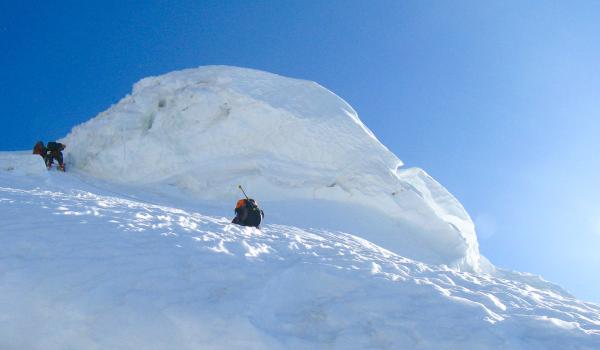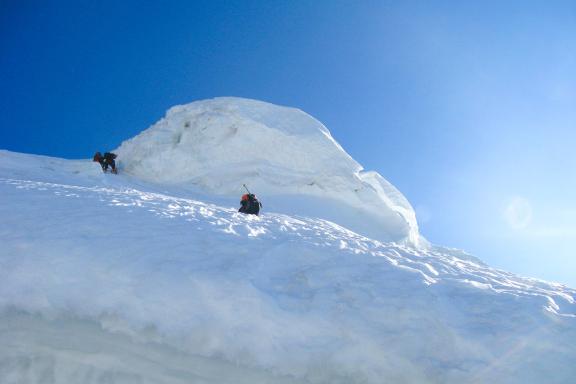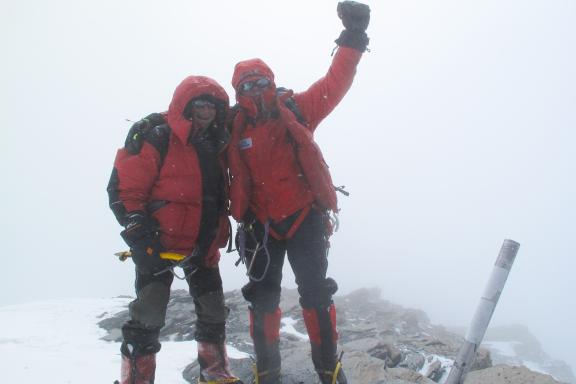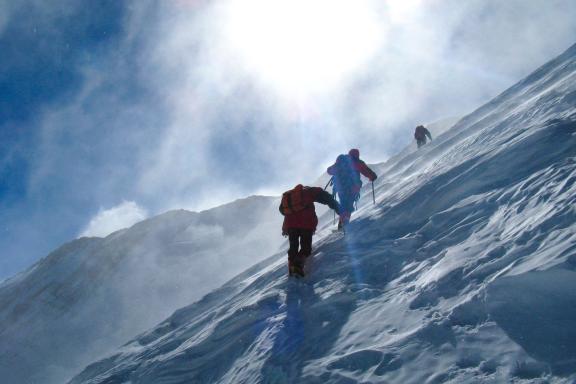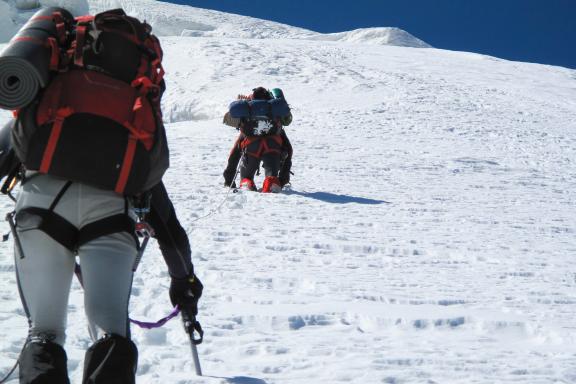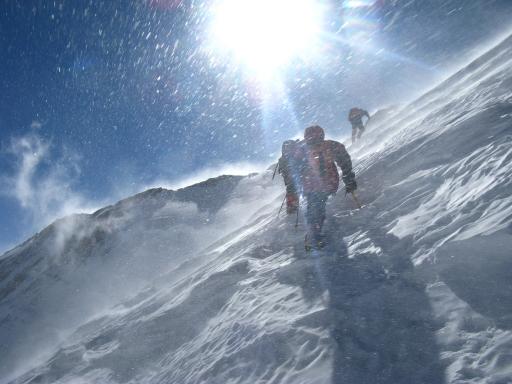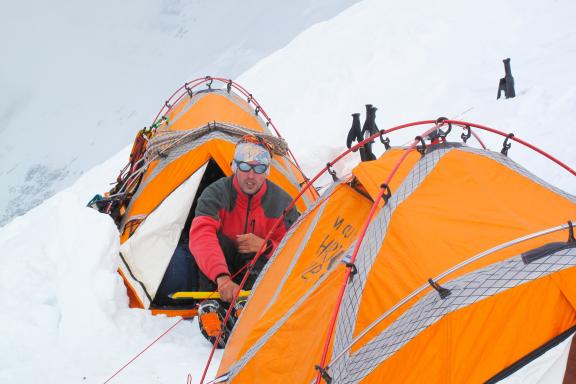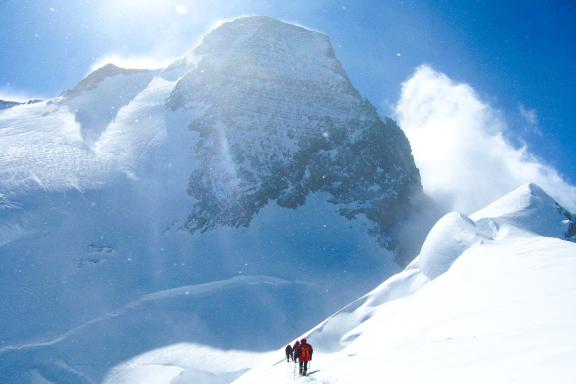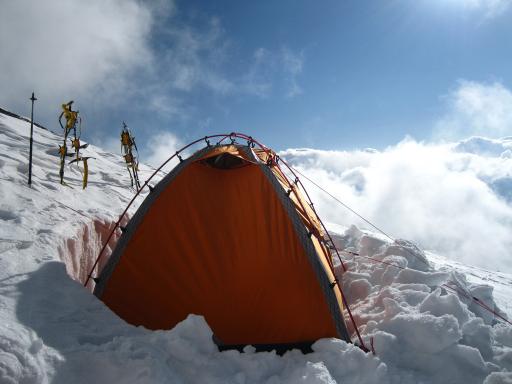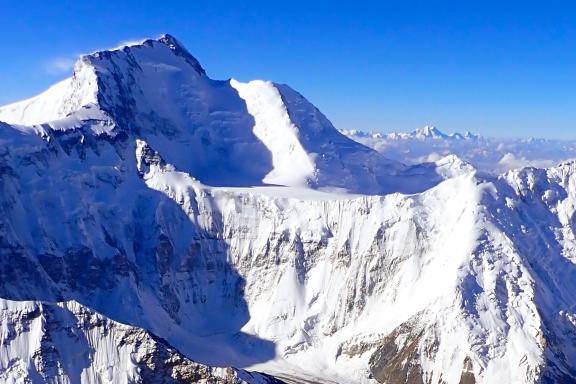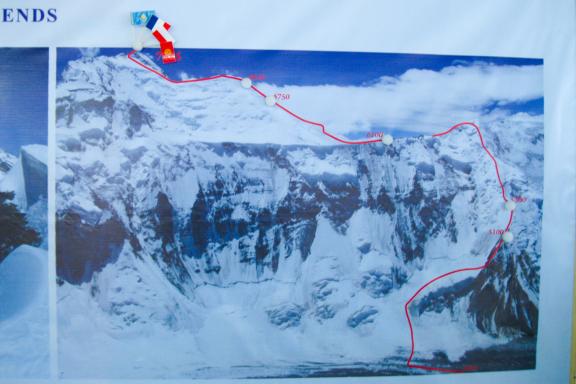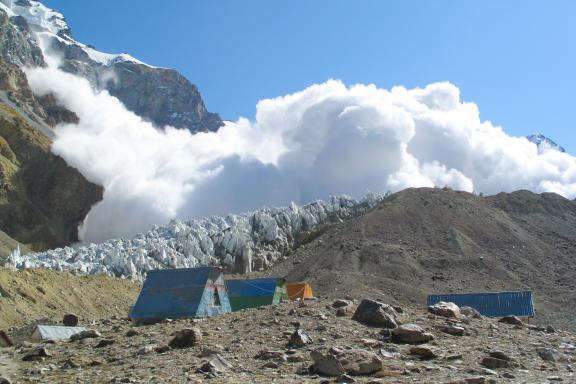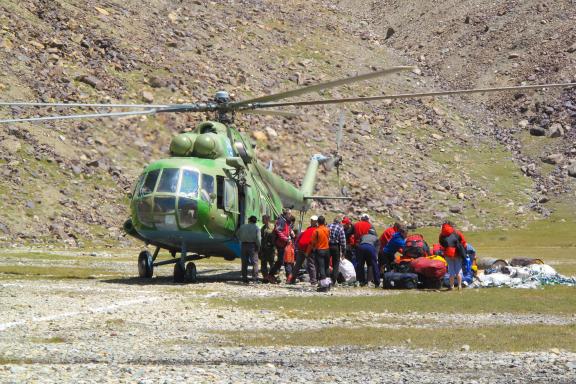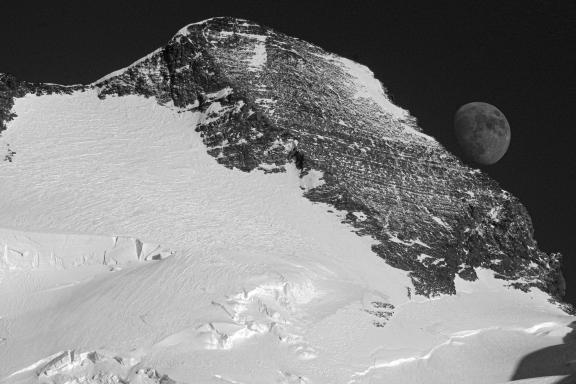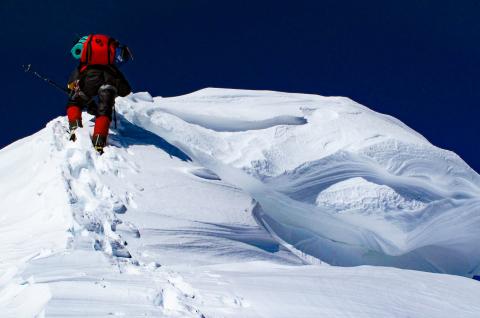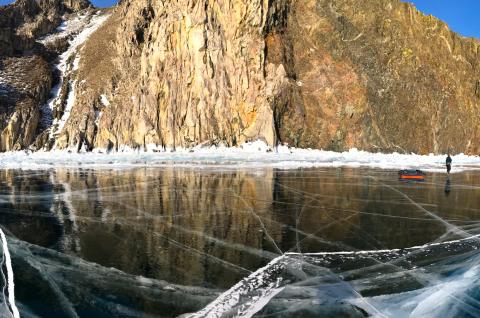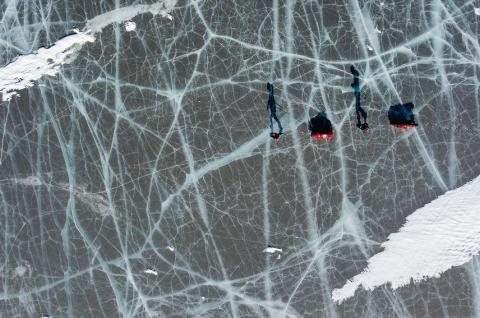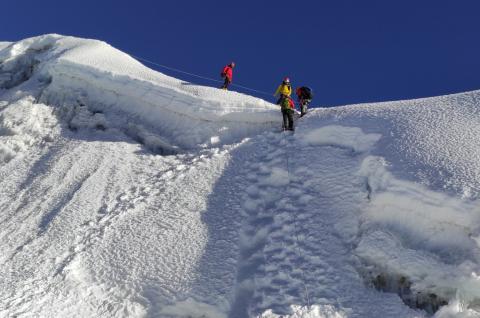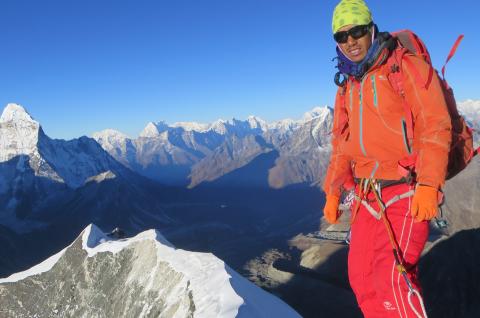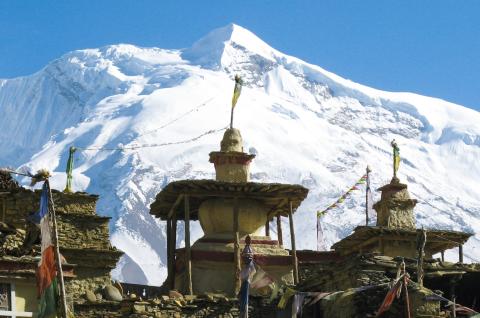The fourth most accessible summit in the Snow Leopard challenge
Highlights
- Central Asia’s highest point
- Highest peak in the Snow Leopard Challenge
- A technically accessible but very long climb
- Several contingency days to cope with climatic fluctuations
- H24 personalized weather forecast and medical hotline
- Preparation course, live coverage of the expedition
The Ismoil Somoni Peak (former Communism Peak), marks the highest point of the former USSR at 7495 meters. The imposing pyramid of rock and summit ice rests on a vast quadrilateral whose four faces present great difficulties in climbing. Between these faces and the summit pyramid, lies the immense Pamirskoe Plateau, one of the largest in the world at such an altitude: three kilometers wide by twelve kilometers in its longest length from west to east. Slightly inclined, it begins at 4700 meters above sea level and culminates at 6300 meters at the foot of the summit pyramid. To access this plateau, the only weak point is on the north face, along the spur Borodkin, named after his first climber who climbed it in 1968. If the steeper passages are less difficult than on the north face of Khan Tengri, they nevertheless require vigilance and ease at altitude.
Overview
ISMOIL SOMONI PEAK
With its 7495 meters, its northern geographical position and above all its endless plateau at more than 7000 meters, the Ismoil Somoni Peak, better known as the Communism Peak, is, along with the Pobeda (Victory Peak), the "big piece" of the Snow Leopard Challenge. Reserved for those with a strong experience of high altitude. The route followed will be that of the classic Borodkin spur which takes place on the north side of the mountain, climbed for the first time in 1968. The route of the first ascent, made by Evgueni Abalakov in 1933 on the east face, is too busy and difficult for a "normal way" on a large summit.
For those interested in the history of mountaineering, the Communism Peak (now Ismoil Somoni Peak) was first climbed in 1933 by one of the two famous Abalakov brothers, Evgueni. The then followed route, extremely long, has rarely been taken since and the "normal way" now takes place via the Borodkin spur.
The ascent is divided into three distinct phases: the ascent of the spur Borodkin which allows us to reach the altitude of 5800 meters. The crossing of the Pamirskoe Plateau (fortunately taken in its width and not its length!). Finally, the ascent of the Dushanbe Peak(6900 m) and the route from the western ridge to the summit. On the way back, from the Pamirskoe Plateau, it is necessary to climb almost 150 meters to reach the Borodkin spur.
Four or even five high altitude camps are needed to complete this long climb. The main difficulty lies in crossing the immense Pamirskoe Plateau with, on return, the hundred and fifty meters to climb back to the top of the spur Borodkin. In case of bad weather on this part of the route, engagement is very important.
BIRTH OF THE "SNOW LEOPARD"
In the 1960s, the USSR was at the height of its glory. But the borders were hermetic and the mountaineers of the Soviet Union expressed their (immense) talent on the many summits that rose from one end of the former Empire of the Tsars to the other. The Himalayas are off-limits to them. But their playground was gigantic: the Caucasus, Pamir-Alay, Fansky (Fann) Mountains, Great Pamir, Tien Shan, Kamtchatka... On 12 October 1967, to encourage and reward the best in the race to the top, the Bureau of the Central Council of Sports Societies and Organisations of the USSR decided to award a prize to those who managed to climb the five highest Soviet summits:
- Khan Tengri Peak – 7010 meters on the Kyrgyzstan-Kazakhstan border
- Korjenevskaya Peak – 7105 meters in Tajikistan
- Lenin Peak – 7134 meters on the Tajikistan-Kyrgyzstan border
- Victory Peak – 7439 meters in Kyrgyzstan
- Ismoil Somoni Peak – 7495 meters in Tajikistan
The reward: to become a "Snow Leopard", the almost mythical animal that haunts the mountains of Central Asia. Many will be lining up to win the prestigious Snow Leopard medal. But almost exclusively climbers from beyond the Iron Curtain, from the Soviet Union. It was not until 1985 that the first two Westerners shared this immense privilege. Two Americans, followed by a Japanese climber in 1989. Finally, in 1997, a French couple, Brigitte and Pierre Meloni, won the prestigious medal. They were the third couple to win a medal. In 2011, Serge Hardy will be the fifth and last Frenchman to win the title. Who will be next?
Five legendary peaks, all in the former USSR
The five peaks of the Snow Leopard Challenge, in ascending order of difficulty:
- Ibn Sina Peak (formerly Lenin Peak) – 7134 meters on the Tajikistan-Kyrgyzstan border
- Ozodi Peak (formerly Korjenevskaya) – 7105 meters in Tajikistan
- Ismoil Somoni Peak (former Communism Peak) – 7495 meters in Tajikistan
- Khan Tengri Peak – 7010 meters on the Kyrgyzstan-Kazakhstan border (the geological altitude is 6995 m, but due to its thick shell of ice at the summit, the official altitude is 7010 m)
- Jengish Chokosu Peak (formerly Victory Peak, formerly Pobeda Peak) – 7439 meters in Kyrgyzstan
Expeditions Unlimited takes on the Snow Leopard challenge with Serge Bazin
Well-known to French-speaking mountaineers, Serge Bazin is a mountain guide (see his biography below). He has been guiding participants on high-altitude summits for many years. We have built up a strong relationship with him. He was our advisor on our first expedition to Manaslu (8163 m), and guided our last expedition to Makalu (8481 m).
He regularly and successfully guided our participants to Lenin Peak at 7134 meters and guided them to the top of the Ozodi Peak (formerly Korjenevskaya) in 2023 .
We are currently forming a close-knit group on these five climbs, the next three of which are massive. Either technically difficult, with the Khan Tengri via the north ridge, chosen because it is less exposed to objective dangers, or in terms of commitment at very high altitude with the Ismoil Somoni Peak and its colossal plateau at 7000 meters and finally, in terms of objective risks, with the famous Victory Peak or Pobeda.
Find here the animated route of the ascent of Communism Peak (Ismoil Somoni Peak) at 7495 meters
Itinerary
Day 0
EXPEDITION SUMMARY PROGRAMME
- Days 1 & 2: Arrival in Dushanbe
- Day 3: Road transfer to Jirgital
- Day 4: Helicopter flight from Jirgital to base camp (4360 m)
- Day 5 & 6: Rest days
- Day 7: Climb to Vorobia Camp 1 (4510 m)
- Day 8: Climb to Vorobia Camp 2 (5200 m)
- Day 9: Ascent of Vorobia (5690 m) and descent to base camp
- Days 10 & 11: Rest days
- Day 12: Climb to Ismoil Somoni Peak Camp 1(5300 m)
- Day 13: Climb to Ismoil Somoni Peak Camp 2 (5800 m)
- Day 14: Carrying to Camp 3 (6100 m) and descent to base camp
- Days 15 & 16: Rest days
- Day 17: Climb to Camp 1 (5300 m)
- Day 18: Climb to Camp 2 (5800 m)
- Day 19: Rest day at Camp 2
- Day 20: Climb to Camp 3 (6100 m)
- Day 21: Climb to Camp 4 (6800 m)
- Day 22: Ascent of Ismoil Somoni Peak (7495 m) and return to Camp 4
- Day 23: Return to Camp 1
- Day 24: Descent to base camp
- Days 25 to 31: Contingency days
- Day 32: Flight from base camp to Jirgital
- Day 33: Transfer from Jirgital to Dushanbe
- Days 34 & 35: Return flight to Europe
EXPEDITION DETAILED PROGRAM
Days 1 & 2: Paris — Dushanbe
Day 1
Departure from Paris for Dushanbe, the capital of Tajikistan. Arrival is usually during the night of day 1 to day 2. Welcome by our local team, then transfer to the hotel. In the afternoon, discovery of the Tajik capital.
Day 3: Dushanbe — Jirgital
Day 3
We take the road north-east to approach the Pamir range. We need to reach the village of Jirgital, where the helicopter base serving the main base camps is located.
Day 4: Jirgital — Moskvina Polyana international base camp
Day 4
A magnificent flight in the imposing MI 8 helicopter that takes us to Moskvina Polyana, where the comfortable international base camp (4360 m) is located. The camp lies at the confluence of the Walter Glacier, which flows down the north face of the Communism Peak, and the Moskvina Glacier, which descends from the Korjenevskaya.
Days 5 & 6: Rest days
Day 5
Quiet days at base camp, to give our bodies time to acclimatise. We will be able to take advantage of this time to get to know the other climbers of all nationalities present at the base camp. The view of the surrounding mountains is majestic, with the Communism Peak in particular, the highest point in the former USSR.
Day 7: Climb to Camp 1 on Vorobiova Peak
Day 7
First day testing our mettle at altitude. The ascent of Vorobiova is not particularly difficult. It is the summit that overlooks the base camp. Halfway between Korjenevskaya and Communism Peak, it is an exceptional viewpoint. The route from the base camp is the same as the route to the advanced base camp on Communism Peak. The camp is located at an altitude of around 5300 meters, making it easier to climb the following day.
Day 8: Climb to Camp 2 on Vorobiova Peak
Day 8
We continue our gradual ascent to a high-altitude camp at 5200 meters, to acclimatize properly.
Day 9: Ascent of Vorobiova (5691 m) — Descent to Base Camp
Day 9
The last part of the ascent takes place on 30° snow slopes. No difficulties other than the altitude. Return to base camp. From the high camp, we follow the face and then the south-east ridge to the summit. Two sub-peaks delay the final ascent, which at this altitude can have a negative effect on one's spirits.
A long descent back to base camp.
Days 10 & 11: Rest days
Day 10
These are essential days for recuperation and to complete our acclimatization.
Day 12: Climb to Camp 1 on Communism Peak
Day 12
From the base camp, we retrace the path we took to approach the Vorobia, along the moraine on the right bank of the Waltera Glacier. At an altitude of around 4600 meters, at the helipad, we set foot on the glacier to cross it towards the base of the Communism Peak. A ramp, known as the "snow pillow", is exposed to falling seracs (it is essential to get there early) and enables us to cross under the very steep slopes descending from the upper plateau (Pamirskoe Plateau). You climb up the steep, rocky ridge that leads to the Borodkin spur. This ridge forms the left edge of the rocky triangle that is clearly visible from below. We end up on the spur where Camp 1 is located (5300 m).
Day 13: Climb to Camp 2 on Communism Peak
Day 13
We continue our ascent along the Borodkin spur, with an average gradient of 35°/40°. Depending on the year, we have to negotiate a few seracs and short passages at between 50 and 60°. The most difficult passages are equipped with fixed ropes. Camp 2 is located not far from the summit of the Borodkin spur, at an altitude of 5800 meters.
Day 14: Climb to Camp 3 and return to Base Camp
Day 14
We set off early in the morning to reach the two characteristic bumps marking the summit of the Borodkin spur (6000 m), known as Grudi (the breasts). From the summit, you have to descend one hundred to one hundred and fifty meters to reach the Pamirskoe Firnovoe Plateau (PFP), an immense expanse of snow stretching three kilometers wide and twelve kilometers long from west to east. The lowest point on the plateau is 4700 meters, rising to 6300 meters at the foot of the Dushanbe Peak. A tedious three-kilometer crossing of the PFP is followed by a portage to Camp 3 at the foot of Dushanbe Peak. The return to Camp 2 is tough, as we have to climb back to the top of the Borodkin spur and then make the long descent to base camp (or even spend the night at Camp 1 if the conditions for crossing under the seracs are deemed too dangerous).
Days 15 & 16: Rest days
Day 15
We spend the last few days in our comfortable base camp before setting off for the summit.
Days 17 to 22: Ascent of Communism Peak
Day 17
We gradually climb back up the mountain, spending the night at Camp 1, Camp 2, Camp 3 and Camp 4 (6800 m). A night's rest at Camp 2 is preferred if conditions permit.
From Camp 3 to Camp 4:
The ascent continues up the north face of Dushanbe Peak to reach the west shoulder at 6956 meters. Camp 4 at 6800 meters is set up at the col that separates Dushanbe Peak from the final slopes leading to Communism Peak proper.
From Camp 4 to the summit :
The route continues along the ridge and then up the steep slopes towards the summit. You join the north ridge, which slopes gently up to the summit. This is the most difficult part of the climb due to the steepness of the slopes, the altitude and the wind. The return is to Camp 4 at the very least, Camp 3 if possible, or better still Camp 2 at the top of the Borodkin spur.
Days 23 & 24: Descent to Base Camp
Day 23
Descent of the Borodkin spur and return to base camp. One or two days are required, depending on the physical condition of the participants and the weather conditions.
Days 25 to 31: Contingency days
Day 25
Contingency days to enable us to refine our climbing strategy and deal with any unforeseen circumstances.
Days 32: Moskvina Polyana — Jirgital
Day 32
Direct helicopter flight back to Dushanbe. A few hours free for any final shopping.
Fay 33: Transfer from Jirgital to Dushanbe
Day 33
We take the road from the village of Jirgital towards Dushanbe.
Days 34 & 35: Dushanbe — Paris
Day 34
Depending on your flight schedule, transfer to the airport and flight to Paris.
END OF EXPEDITION
For reasons that cannot be foreseen at this stage, such as unpredictable weather, the physical fitness or lack of fitness of participants or other circumstancess (customs formalities, road conditions, traffic, landslides, force majeure, etc.), your expedition leader may have to adapt the program, if necessary, to ensure the smooth running of your trip. He remains the sole judge and the one who guarantees your safety. Activity times are given as an indication and may vary from one participant to another.
The itinerary for all our expedition programs, or the ascent program for our high-mountain expeditions, are given here as a guide only. They are flexible enough to adapt to weather conditions with a few contingency days. In any case, you should follow the recommendations of your guide, who may suggest that you cancel your expedition due to weather, safety or physical conditions.
It is important to remember that this is a truly unsupported expedition, and that anything can happen. Expeditions Unlimited, your expedition leader, your guide or our local teams can in no way be held responsible.
Any costs incurred as a result of a change in the expedition schedule (extra nights' accommodation, extra flights) will be borne by the participants and not by the organizers. "Contingency days" refer to the expedition in the strict sense of the term (base camp/base camp in the mountains, departure point/exit point on a traverse, etc.).
Any early return of the expedition or of certain members only (early success, abandonment, etc.), generating costs for accommodation, meals, changes to air tickets or other activities not provided for in this program, will be charged in full to the participants.
Trip notes
Guiding
French mountain guide Serge Bazin.
For unpredictable reasons at this stage, like adverse weather conditions, insufficient physical condition of participants, insufficient competencies of participants related to the intended activities, your guide may decide to adjust the intended program and/or activities. At all times, his decision will be final on all matters likely to affect the safety and well-being of the trip.
Difficulty level
Level rated: difficult
This program is aimed at participants in good physical shape, with a significant sport practice, endurance in particular, holding a strong mental to face difficulties that are unforeseen by nature.
Ismoil Somoni Peak (former Communism Peak) is rated as "difficult" because of the conditions you will be facing: very high altitude, very low temperatures, sometimes bad weather and strong winds.
To be as self-sufficient as possible, you need to have significant mountaineering experience and be actively involved in hiking, trekking or mountaineering. You need to be able to progress in a roped party, either on your own or roped up with a guide, and you need to know how to handle ropes.
For a relatively long period of time, the body will be subjected to considerable physical effort in a difficult environment, with the added handicap of high altitude. Rigorous training is obviously necessary, focusing on developing endurance and resistance: running, cycling, swimming, ski touring and, of course, mountaineering. This training needs to be regular and begins at least 6 to 8 months before the start of the expedition.
Team spirit is also important. Each participant is responsible for applying safety rules, looking after his or her own equipment and maintenance, setting up the camp and preparing meals. As always in this type of project, the key to success is teamwork and team spirit.
Participation in the preparation course with your expedition leader, whose date will be specified later, is highly recommended. In addition, mountaineering preparation courses at our School of Adventure can be a serious asset, both to gain confidence and autonomy.
To register for this expedition, you will be asked to provide an expedition (mountain climb list)/trek/athlete CV. A medical certificate stating that you are not at risk of climbing at high altitude is also required.
You benefit, free of charge and for the duration of your expedition, from membership in the 24/7 high altitude medical service set up with our partner Ifremmont, of which we are partners. See below.
Technical difficulty
Mountaineering level: PD like... A little difficult (Peu Difficile in French)
In this program, the use of mountaineering equipment (crampons, harness, ice ax, ropes, etc.) is necessary and the route tackled may involve small difficulties, whether it is a little more inclined during glacier mountaineering, height of the walls, the length and the continuity of the efforts. It is therefore aimed at rough beginners who already have a little experience in mountaineering, who have already completed a few ascents of this level or slightly below. The mountaineering courses at our Adventure School from three days are for you. And this technical rating applies of course to normal weather conditions: the difficulty can increase in the event of bad conditions, fresh snow on rocks, insufficient or lack of quality of ice , etc. Likewise, the situation changes radically, for the same technical level, with the altitude, the weight of the bag, the lack of equipment on the route, the fatigue associated with the approach if it is long, the environment, if particularly hostile, etc.
Compagnies aériennes internationales
Scheduled flights to and from Dushanbe and from the provinces with Turkish Airlines.
Important: airlines sometimes change their departure/arrival times: morning instead of evening and vice versa. It is therefore possible that the first and last days of the programme may be changed depending on the airline rotations at the time.
Accommodations
Hotels in Dushanbe: 3-star local standard in a double room with breakfast. Single rooms are available at extra cost.
The base camp is located in a green area, where the temperature remains mild. We are accommodated in a two-person tent, with wooden supports to isolate you from the ground and a mattress. Electricity is provided at the base camp, as are hot showers. Wifi is available, but at a charge.
A large heated mess tent houses the expeditions of the different nationalities that share the base camp.
From Camp 1 onwards, you will be in a two-person expedition tent, with three people in the last camp.
All the camps have a storage tent where you can leave any equipment or belongings you are not taking with you.
Meals
At Dushanbe, only breakfast is included. Depending on the flight plan, you should therefore plan to pay for your meals on the spot, which gives you a little freedom to choose your food.
At base camp, meals are prepared by our local team using local produce and served in the mess tent.
For the higher camps, you will be able to compose your own menus in the form of freeze-dried rations. These rations contain coffee and tea, cereals, mashed potatoes, soup, broths, Chinese noodles, freeze-dried dishes, snacks, etc. Remember to bring your favourite energy bars, as the choice is not exceptional in Tajikistan!
HYDRATION
Take along tablets (such as Hydroclonazone, Micropur or others) to disinfect the water you put in your water bottle, depending on the source and on the advice of your guide. It is sometimes possible to buy purified water and fill your bottle without having to buy bottled water. You can also buy "mineral" water in the towns (not included in the price), but as you know, it has a poor environmental performance. So we do not recommend it.
Transfers / Transport
On the outward journey, transport between Dushanbe and the town of Jirgital is provided by private minibus. By MI-8 helicopter between Jirgital and the base camp. On the return journey, the same helicopter will take you directly from the base camp to Dushanbe, or if not to Jirgital.
Group size
The group is made up of a maximum of 4 to 6 participants. The number of participants is deliberately limited to allow for greater immersion, to avoid embarrassing our hosts, and to develop freedom and flexibility. However, the maximum number may be exceeded if the last person to register wishes to travel with one or more other people. The services will not be modified, and the conditions of the trip will remain the same.
Equipment
Personal equipment is not provided. A full list is given later in this document. It will be refined with the expedition leader during the preparation days and up to the moment of departure, depending on your questions.
All logistical equipment is provided, including high altitude tents and all collective and individual cooking equipment. Your guide will have a satellite telephone to keep in touch with the outside world, as well as communication and safety equipment, a geolocation beacon, etc. The expedition has a hyperbaric chamber, and a collective pharmacy is available, although it does not replace the compulsory individual pharmacy, a list of which will be provided by Ifremmont.
COMMUNICATIONS
The Iridium satellite phone is used for logistical, weather and safety purposes only. Under certain conditions, participants will be able to use this telephone. For these private uses, please contact us.
At the time of writing, all participants are free to bring any systems they may have. We will just need to be able to declare them to our contacts, so please let us know in advance.
Please note: in order to preserve the serenity of this expedition and the privacy of the participants, we ask you not to communicate with the general public during the expedition. You are, however, free to send information about yourself to your private sphere. By registering for this program, you accept this essential clause to protect the privacy of other participants in a project of this scale, where important issues of image, physical risk and financial considerations (sponsors, etc.) are at stake.
Our commitments to sustainable development
Our commitment to a better planet has been a reality since the beginning of our story but we always need to do more and better. Please find out more about our charter and our commitments in terms of sustainable development. We have drafted our charter and take action through six themes on which we act as concretely as possible, most often with you: social equity and cultural respect, preservation of water, waste management in expedition, protection of biodiversity, raise public awareness on these subjects and finally, the optimization and recovery of CO2 emissions.
Regarding carbon emissions, most of which are due to air travel, we calculated and communicated in 2018 on the carbon footprint of each of our programs, expressed in tonnes of CO2.
These calculations made us aware of the importance of the total carbon emissions generated by our activity. Also, we have committed in 2022 to a carbon reduction that we believe is unprecedented in the tourism industry, aiming to reduce the total emissions of our activity by 5% per year, taking 2019 as the reference year (3,430 tonnes of CO2). This commitment is in line with the trajectory of the Paris climate agreements of 2015, the current benchmark. Thus, in 2030, we commit ourselves not to exceed 2,160 tonnes of C02. Thus, our maximum “carbon” budget for 2024 is 2,950 tonnes and for 2025, this budget will be reduced to 2,800 tonnes. And so on until 2030. To find out more about all of our calculations and our commitments in terms of reducing our carbon emissions.
In addition, since 2019, we have been encouraging you when you book for your journey to contribute with a donation to an independent NGO, among the two we have selected that share the commitments made in our charter. We matched the amount of this donation to this program's carbon footprint. Thus, the journey you are considering generates 4,52 tons of CO2, which corresponds to a 100% donation of €136 for an estimated value today of €30 per tonne of CO2. This donation remains of course optional and you can decide to give between nothing and 100% of this amount. Since 2019, including covid years of 2020 and 2021, we have been able to collect thanks to you nearly €7,000 for these associations.
Please do not hesitate to come back to us with any questions you might have regarding this carbon footprint mechanism, our other sustainable développement commitments or even to share with us your experience through a chat or a mail at contact@secret-planet.com.
Serge Bazin, mountain guide
Originally from Toulon, Serge Bazin did his military service with the Alpine hunters in Bourg-Saint-Maurice. Trained as a topographer and surveyor, he moved to Chamonix in 1985. Together with a team of surveyors, they regularly measure the summit of Mont Blanc, which they climb on foot or skis. In 2021, they will celebrate their twentieth measurement!
For over 20 years, he has been concentrating on his job as a mountain guide, and has travelled all over the world, tackling rare or well-known summits, with participants he guides or with friends. He gives training courses, and prefers self-guided alpine-style expeditions in snow, ice, rock or mixed terrain. He has climbed several "big walls" (El Capitan eight times in Yosemite, USA).
He has been passionate about the Himalayas, and Nepal in particular, for 30 years, and returns there every year, either alone or with participants. Treks, traverses, ascents to 6000, 7000, 8000... His experience makes him one of France's most experienced high-altitude guides.
- Serge has guided participants to the summits of three eight-thousanders: Makalu (8475 m), Manaslu (8163 m) and Cho Oyu (8201 m).
In addition to numerous treks and passes approaching 6000 meters, his list of Asian climbs includes the following peaks, usually with participants he guided, and sometimes several times :
- Summits over 7000 meters: Himlung Himal (7127 m), Lhakpa Ri (7043 m), Korjenevskaya Peak (Tajikistan, 7105 m) and Lenin Peak (Kyrgyzstan, 7134 m), which he has climbed four or five times. He has also attempted the rare Nepalese peaks of Makalu 2 (7650 m – stop at 7500), Langtang Lirung (7200 m – stop at 7000), Ratna Chuli (7127 m– stop at 7000) and Gyanjing Kang (7200 m – stop at 6600 m) with other participants;
- Summits over 6000 meters: Ama Dablam (6856 m), Mera Peak (6470 m), Island Peak (6187 m), Lobuche Peak (6100 m), Pacharmo (6273 m), central Kongde Ri (6187 m), Kyajo Ri (6186 m), Daulhagiri VI – Ongde (6500 m), Chulu West (6419 m), Chulu East (6584 m), Thorung Peak (6100 m), Dhampus Peak (6012 m).
Since 1993, Serge has been offering children special "child walkers" trekking tours, which have seen some forty 8–18 year-olds trekking Nepal with him over the years. Some of them have since become guides...
Finally, he is a guide-trainer for ANENA - Association Nationale Etude Neige et Avalanches, a Grenoble-based training and information institute founded in 1971 by Louis Néel, winner of the Nobel Prize for physics.
In short, Serge has the experience and teaching know-how to optimize your expedition's chances of success, both technically and in terms of group management, both in terms of the pace at which the group builds up its strength and in terms of its progress, which are key elements in this type of expedition.
Departures and pricing
Please find below all dates and prices for this expedition. Prices are quoted "from" and may be adjusted notably according to the number of participants (see trip notes for details). Please note that dates and prices for years beyond 2024, when given, are for guidance only and are subject to change and readjustment to take account of current economic realities.
No date works for me!
I initiate a new datePrice includes
Transfers tel qu’indiqués dans le programme. Accommodations tel qu’indiqués dans le programme. Meals tel qu’indiqués dans le programme. Guiding tel qu’indiqués dans le programme. Equipment tel qu’indiqués dans le programme. Travel folder tel qu’indiqués dans le programme. Parks and reserves tel qu’indiqués dans le programme.
Price does not include
All accompaniments, accommodations or meals mentioned “not included” in the program. Drinks and personal “extras”. The “single” supplement or a different hotel category. Other supplements linked to a lower number of participants registered, your desire to customize or privatize the expedition. The mandatory expedition complementary insurance.
Your custom expedition
We put our expertise, our knowledge of the terrain, our creativity, our experience, the quality of our guides and the reliability of our partners at your service to build your custom expedition. We can also personalize an expedition to your wishes as soon as you form a "closed" group, whatever the number of participants.
This means that, unless you authorize us to do otherwise, no outside participants join you, and we can personalize your expedition by adapting it to your own pace, with the program extensions you desire, a higher level of comfort, certain activities, other encounters, etc.
Every expedition of this type is subject to a specific quotation. To get in touch with us now, please fill in the short questionnaire below. One of our experts will get back to you to refine your request and make you a proposal.
